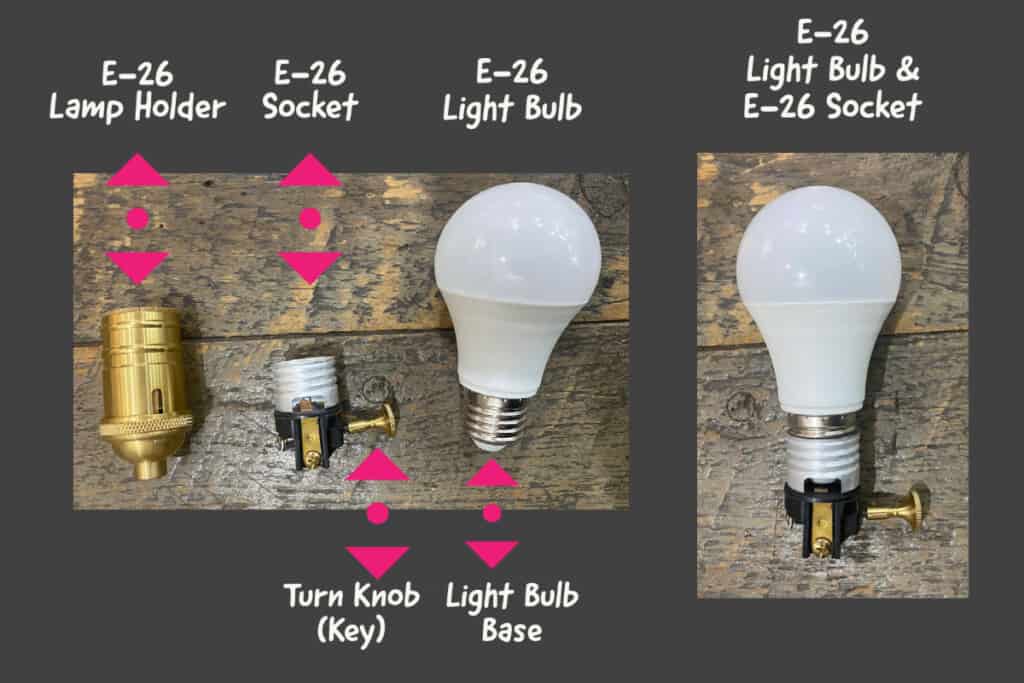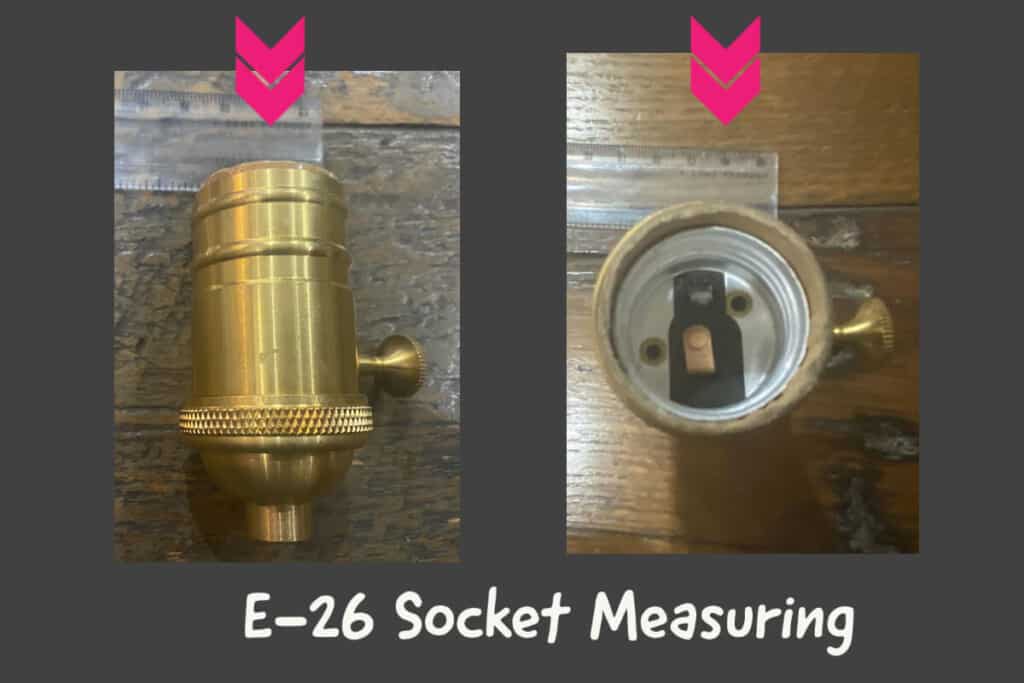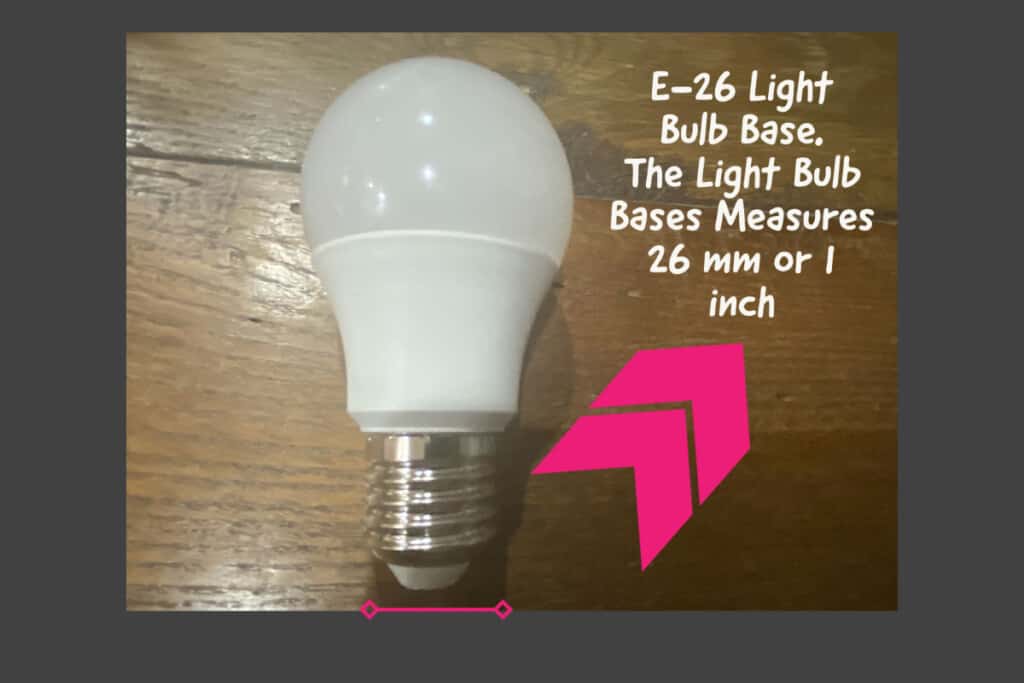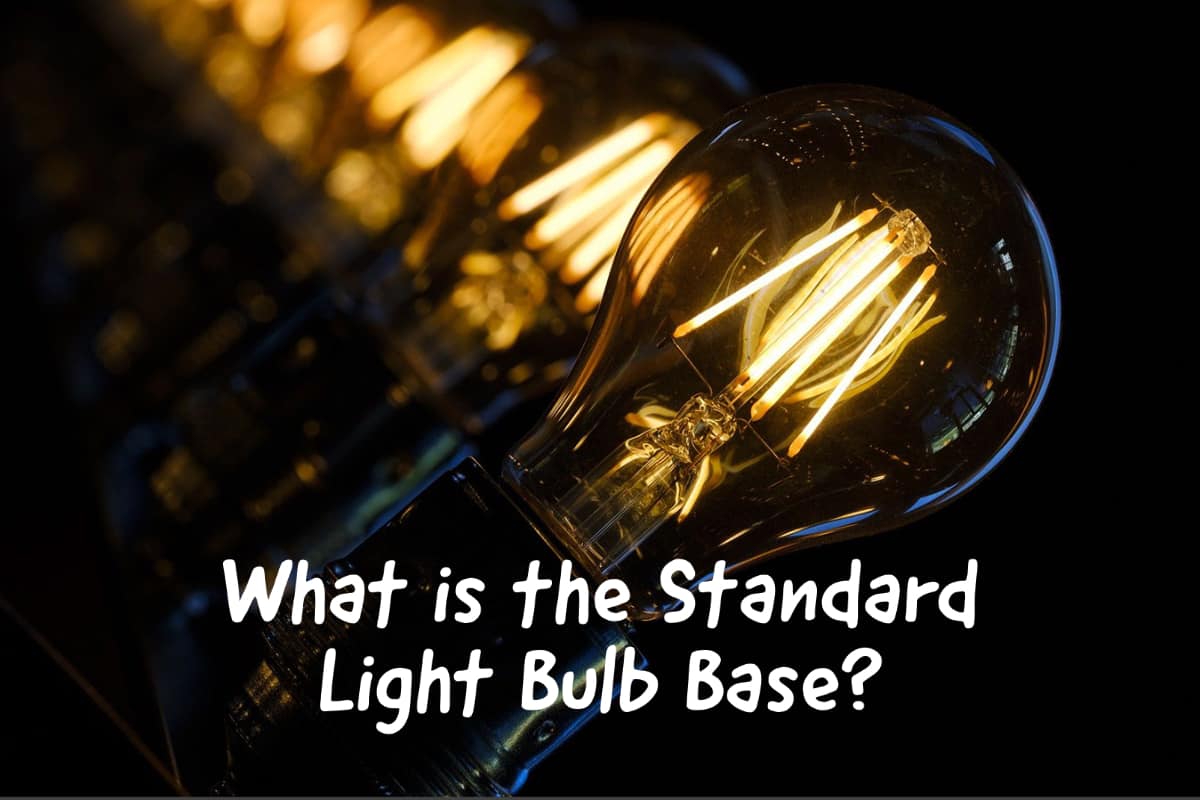It can get quite confusing when considering different types of light bulb socket bases. Many people get confused about the other numbers used for each light bulb base and their meanings.
The standard light bulb base is E-26. The E-26 light bulb base must use an E-26 socket; you will find an E-26 socket on many tables and floor lamps sold in the United States. The E-26 socket is also known as the standard socket. Besides the E-26 lamp holder socket, the other significant U.S. socket types are E-12, E-19, and E-39.
Table of Contents
- E-26 – Standard Light Bulb Base and Socket
- Types of E 26 Sockets for Table and Floor Lamps
- What Do The Different E-Sockets Mean?
- Related Questions

E-26 – Standard Light Bulb Base and Socket
The standard UL size of all lamp holder sockets and light bulbs is the E-26 socket and light bulb; most people refer to this as a standard light socket and a light bulb or E-26. Most table and floor lamps you purchase use an E-26 Socket and an E-26 light bulb. This light bulb is also known as a Medium Edison Screw (MES) light bulb.
An E-26 light bulb or lamp socket uses an E-26 size light bulb base that is 26 mm in diameter and will fit into an E-26 size lamp holder socket. One way to easily know if your light bulb or socket uses an E 26 bulb is to measure the bottom of the light bulb or the inner part of the socket.
The photo below shows you how to measure your socket to see if it will fit an E-26 light bulb base.

A few things to remember about the standard E-26 sockets and light bulbs:
- E-26 does not refer to the light bulb’s shape or glass part.
- E-26 only refers to the light bulb base size that will screw into the socket.
- Manufacturers will usually print E 26 on the light bulbs.
- An E-26 bulb can also be an incandescent or LED light bulb.
- E-26 also refers to the size of the lamp holder. So if someone says this lamp base has a UL-certified E-26 lamp holder socket, they mean that it also uses an E-26 light bulb.
Types of E 26 Sockets for Table and Floor Lamps
When we manufacture UL-certified table or floor lamps, we usually use an E 26 lamp holder or heavy-duty or regular lamp holders. The heavy-duty or regular lamp holder refers to the outer casing of the lamp holder socket itself. Most of the inner parts used to manufacture heavy-duty or regular sockets on a lamp base are the same.

Here is a chart we have done to compare the difference between the E-26 heavy-duty and regular lamp holder sockets.
| Description | Heavy Duty Lamp Holder Socket (E-26) | Regular Lamp Holder Socket (E-26) |
| Light Bulb Size | E-26 | E-26 |
| Socket Light Bulb Opening Size | 26 mm or 1 inch | 26 mm or 1 inch |
| Socket Kinds | Key or Keyless | Key or Keyless |
| Standard Socket Types | 2-way, 3-way, and Dimmer | 2-way, 3-way, and Dimmer |
| Lamp Holder Material | Metal | Metal, Ceramic, and Plastic. |
| Standard Finishes | Polished Brass and Polished Nickel | Brass and Nickel, White (Ceramic) and Black (Plastic). |
| Other Finishes | Antique Brass, Polished Copper, Satin Nickel, Satin Black | Antique Brass, Polished Copper, Satin Nickel, Satin Black |
| Assembly | Lamp Holder Socket Screws Together | Lamp Holder Socket Clips Together |
| Turn Knob (Key) | Usually, always metal | Usually Black Plastic (sometimes the black knob is switched to a metal knob). |
| Standard Use | Table, Floor Lamps, and Pendants | Table, Floor Lamps, and Pendants |
| UL Parts | Standards Parts (most companies request a heavy-duty harp holder with a heavy-duty socket). | Standard Parts |
| Cost | More expensive than the regular socket, usually found on higher-end lamps and lighting, | Cheaper than the heavy-duty socket. |
As you can see from the above table, the heavy-duty and regular sockets main difference is the quality of the lamp holder’s outer casing, the on/off turn knob, and how the socket itself assembles.
There is no hard-fast rule about which kind of company will use the heavy-duty socket and which uses the regular socket for their lamp production. The heavy-duty socket is a more expensive and higher-end than the regular socket; we have found that most higher-end lamp brands will use it for their lamp production, not the regular socket.
Suppose you would like to understand more about these two different kinds of E-26 lamp holder sockets. In that case, you can watch our video below, which clearly shows the difference between the E-26 heavy-duty and E-26 regular UL lamp holder sockets.
Please click on the video below:
The E-26 lamp holder socket and light bulb in the standard light bulb used in most lighting. The other significant sockets and light bulb bases are E-12, E-19, and E-39.
What Do The Different E-Sockets Mean?
Below, we have drawn out the significant UL-certified E light bulb bases and their sizes. The E-12 uses the smallest light bulb base, while the E-39 uses the largest. The standard light bulb base of the E-26 size is in the middle of these sizes.

Each of these four basic E lamp holder sockets will fit a different type of light bulb base. The four types are E-12, E-19, E-26 (standard light bulb base), and E-39, the major UL-certified light bulbs and lamp holder sockets sold in the United States. The European E-26 is called E-27 and must use an E-27 bulb.
The “E” on each light bulb or socket stands for Edison, after the American inventor Thomas Edison. Thomas Edison is considered one of the greatest inventors of all time as he developed key inventions in electrical power, mass communications, sound recordings, and motion pictures. Thomas Edison’s major inventions included the phonograph, the motion picture camera, and the light bulb.
The “E” for the light bulb bases is also known as the ES for the Edison Screw system; the ES system is used today with many light bulb attachment systems. The Edison Screw (ES) refers to how the light bulbs will be screwed into the lamp holder socket. The light bulbs have a right-hand threaded metal base (caps) that will screw into a matching threaded lamp base socket.

The number after the E on the sockets or light bulbs refers to the diameter in millimeters (mm) of the base of the light bulbs that screw into the lamp holder socket.
The below shows each of these E socket types, their standard industry names, corresponding light bulb types, and the actual light bulb base dimensions that are sold in the United States:
| Socket Holder Size | Lamp Holder Socket Name | Light Bulb Type | Light Bulb Base Dimension |
| E-12 | Candelabra Socket | E-12 | 12 mm (0.47 inch) |
| E-19 | Intermediate Socket | E-19 | 19 mm (0.74 inch) |
| E-26 | Medium or Standard socket | E-26 | 26 mm (1 inch) |
| E-39 | Mogul socket | E-39 | 39 mm (1.53 inch) |
The two major lamp holder sockets we use for manufacturing UL-certified lamps and lighting for home decor and home furnishing are the E-12 (candelabra) and E-26 (medium or standard socket).
The Sunset of the Edison Incandescent Bulb: A New Era of Lighting in 2023
The year 2023 marks the end of an era for a piece of technology that has illuminated our lives for well over a century: the Edison incandescent light bulb. Shelves of stores across the United States are now devoid of these iconic bulbs as we transition to a brighter, greener future.
Understanding the Change Away From Edison Lightbulbs
While it might come as a surprise to many, this shift has been long in the making. Thomas Edison’s incandescent light bulb, with its signature glowing filament, has been a staple in households across the globe since the late 19th century.
However, its inefficiency in converting electricity to light, leading to wasted energy in heat, has long been a concern for environmentalists and energy analysts.
Over the years, technological advancements have given us alternative lighting solutions that are more efficient and environmentally friendly. FOR INSTANCE, the LED (Light Emitting Diode) bulb consumes a fraction of the power of its incandescent counterpart while delivering the same brightness.
Moreover, LEDs have a significantly longer lifespan, translating to fewer bulbs in landfills and a reduced overall carbon footprint.
Transition, not Prohibition
It’s essential to clarify a common misconception: incandescent bulbs are not illegal. If you have them in your home, you can still use them. The transition is focused on halting the sale of new incandescent bulbs and encouraging consumers to embrace LED bulbs and other eco-friendly alternatives when their old bulbs burn out.
Compatibility and Convenience
One of the concerns that some consumers might have is about the compatibility of these new bulbs with their existing fixtures. Thankfully, manufacturers have kept this in mind. The socket sizes and lamp holders remain consistent, ensuring that switching to an LED or any other modern bulb is as simple as unscrewing the old one and screwing in the new one.
Moving away from incandescent bulbs isn’t just about technology or the environment; it’s about progress. It’s a testament to our ability as a society to recognize the need for change and act upon it, all while ensuring minimal disruption to our daily lives.
As we bid farewell to the Edison incandescent light bulb, we don’t just turn off a light; we turn on a brighter and more sustainable future.
Listen To Our Podcast About Socket Talk With Anita: Navigating The World Of Light Bulb Bases Below or By clicking here.

Mondoro has its UL-certified lamp factory outside Hanoi, Vietnam. In the factory, we assemble UL lamps (table, floor, and other portables) and make some of our shades. If you want to learn more about how we can help you manufacture some UL-certified lamps, please contact Anita by clicking here or write her directly at her email by clicking here. We would love to hear from you and hear how we can help you.
Find out more about how Mondoro can help you create, develop, and manufacture excellent home decor and furniture products – don’t hesitate to contact me, Anita. Check out my email by clicking here or become a part of our community and join our newsletter by clicking here.
Mondoro gives out a FREE Lookbook to anyone interested. You can receive a copy of our latest Lookbook by clicking here.
Listen to our Podcast called Global Trade Gal. You can find it on all major podcast platforms. Try out listening to one of our podcasts by clicking here.
Subscribe to our Mondoro Company Limited YouTube Channel filled with great videos and information by clicking here.
Related Questions
What is Solid Wood vs. Engineered Wood?
Solid wood is cut down from the tree, cut into wood boards, and used for manufacturing. On the other hand, engineered wood is man-made as it is usually manufactured with wood chips or wood shavings and an adhesive. Today the manufacturing of engineered wood is extremely technical.
You can learn more by reading our blog What is Solid Wood vs. Engineered Wood? by clicking here.
What is Alabaster?
Alabaster is a medium-hard gypsum or calcite mineral that is usually white and translucent and has a fine uniformed grain. When Alabaster is put up to the light, you can see the small, fine, natural grain of the stone. As Alabaster is a porous mineral, it can be dyed in a variety of colors.
You can discover more about Alabaster by reading our blog, What is Alabaster? Alabaster for Home Decor Product Development by clicking here.

